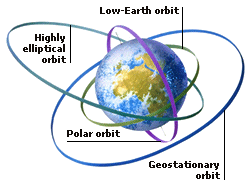DK Science: Satellites
An object that circles another in space is called its satellite. Earth has one natural satellite, the Moon, but a swarm of artificial satellites. The USSR launched the first artificial satellite, Sputnik 1, in October 1957. Today, thousands of satellites circle Earth in different ORBITS, doing all kinds of jobs, such as relaying phone calls and TV broadcasts, and monitoring weather.
Satellites are built of the lightest materials possible to make them easier to launch. They can carry a wide variety of instruments, such as cameras, telescopes, radiation sensors, and radio equipment. Panels of solar cells provide electricity to power the instruments.
Earth stations use huge dish antennae to beam radio waves up to communication satellites. The satellites beam them back down to other Earth stations in the same or a different country. Many national and most international telephone calls, emails, and fax messages are now handled by networks of communications satellites, many of them in geostationary orbit.
Satellites circle in space around Earth in a variety of paths, or orbits. They are kept in orbit by achieving a balance between their speed and the force of gravity: speed pushes them outward, while gravity pulls them inward. The speed needed to stay in orbit at a given height is called orbital velocity. For orbit at a few hundred kilometres, the orbital velocity is 28,000 kph (17,500 mph).
Table 19. SATELLITES AND THEIR ORBITS
| Low-Earth orbit | Mobile communications, reconnaissance, astronomy |
| Polar orbit | Weather, navigation |
| Highly elliptical | Communications at orbit northern latitudes |
| Geostationary orbit | Communications, weather |

Satellites follow different orbits around Earth. In a polar orbit, they circle over the poles. In a highly elliptical orbit, they swoop close to Earth at one point but move far away at another. In a geostationary orbit, 36,000 km (23,500 miles) high, they circle every 24 hours and appear fixed in the sky. A low-Earth orbit is only a few hundred kilometres above Earth.
